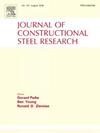A unified design model to assess the shear behaviour and ultimate strength of a cold-formed steel welded and bolted clip-angle connection
IF 4
2区 工程技术
Q1 CONSTRUCTION & BUILDING TECHNOLOGY
引用次数: 0
Abstract
In the present research work, a series of 70 laboratory tests were carried out to investigate the shear characteristics of a CFS welded clip-angle (WS) connection. The WS connection primarily exhibits failure modes such as (i) local buckling and (ii) distortional buckling of the clip-angle, in addition to a CFS column bearing failure. The impact of column bearing failure on the ultimate shear strength of the WS connection is investigated. A detailed parametric study is undertaken to analyze the effects of design variables on the different failure modes and the ultimate strength of the WS connection. Following the conventional two-step process, a design approach for the WS connection is developed like (i) failure modes were classified using aspect ratio (width/depth) and (ii) a new design equation was developed to predict the ultimate shear strength. Nonetheless, it is important to note that these two design steps are not interrelated. Therefore, the present research introduces a unified design model to assess and relate the failure behaviour and ultimate strength using a failure index factor. Unlike conventional method that overlook thickness impact on failure mode categorization, the current failure index factor considers all relevant design variables. The suggested design methodology has been expanded to the CFS bolted connection and shows a good agreement with the literature data of 114 bolted CFS connection tests. A comparative study was executed on the welded and bolted CFS shear connection and design guidelines have been formulated. A reliability assessment of the developed design models for both welded and bolted CFS connections has been carried out. A design example is provided to elucidate the design methodology.

求助全文
约1分钟内获得全文
求助全文
来源期刊

Journal of Constructional Steel Research
工程技术-工程:土木
CiteScore
7.90
自引率
19.50%
发文量
550
审稿时长
46 days
期刊介绍:
The Journal of Constructional Steel Research provides an international forum for the presentation and discussion of the latest developments in structural steel research and their applications. It is aimed not only at researchers but also at those likely to be most affected by research results, i.e. designers and fabricators. Original papers of a high standard dealing with all aspects of steel research including theoretical and experimental research on elements, assemblages, connection and material properties are considered for publication.
 求助内容:
求助内容: 应助结果提醒方式:
应助结果提醒方式:


